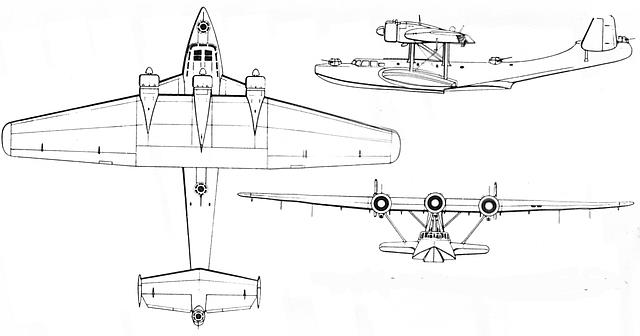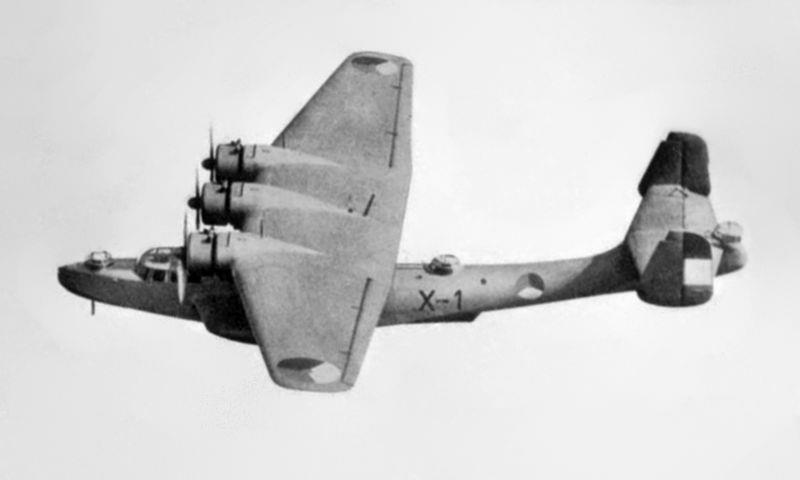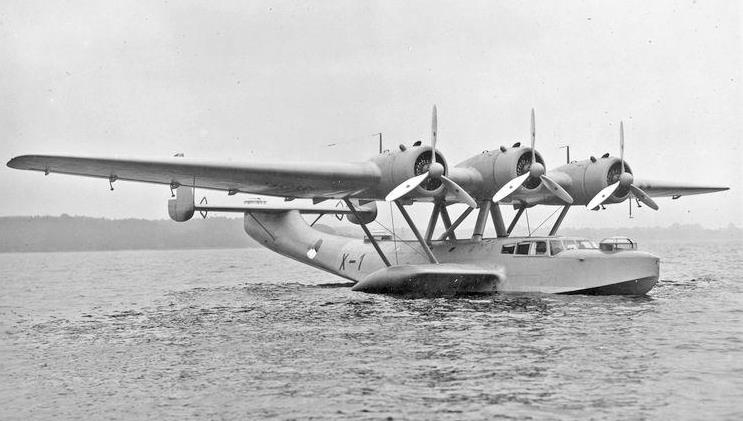| Type |
K 6-seat SAR |
T |
| Engine |
3 Wright Cyclone GR 1820-F52 with Hamilton Type 3E 50-31, 3-bladed metal, constant speed, 3,50 meter diameter, |
3 Bramo 323R-2 Fafnir with 3-bladed VDM variable-pitch metal propellers |
| Dimensions |
Length 22,0 m , height 5,8 m , span 27 m , wing area 108 m2 , stabilizer 18,44 m² rudders 9,10 m² flaps 8,75 m² |
Length 22,05 m , height 5,75 m , span 27 m , wing area 108 m2 , |
| Weights |
Empty 9200 kg , loaded 12400 kg, max. take off weight 8 Stummel tanks (2670 liter) and 2 wing tanks (1880 liter) totaling 4550 liter
Oil 3 tanks totaling 390 liter |
Empty 9400 kg, loaded 13700 kg , max. take off weight 18400 kg
Fuel 5,300 l in two 1,000 l wing tanks and twelve small tanks in the sponsons |
| Performance |
Max.. speed 300 km/h , cruising speed , range , endurance , service ceiling 5100 m , climb to 3000 m 10 min. 30 sec. |
Max.. speed 330 km/h at 2600 m, 290 km/h at sea level, cruising speed 295 km/h at 2600 m , range 2900 km, ferry range 4700 km , endurance , service ceiling 7500 m , climb to 2000 m 6 min., to 4000 m 13 min. 12 sec. |
| Armament |
Three Colt-Browning 7,7 mm machineguns with 500 rounds each.
bombs 600 - 1200 kg |
1 20 mm ( Hispano HS.404 or MG151 autocannon in dorsal turret 1 7.92 mm MG 15 machine gun in nose turret 1 7.92 mm MG 15 machine gun in tail gun position Bombs: 1,200 kg under the wings |
The Dornier Do 24 was designed to meet a Royal Netherlands Navy requirement for a replacement of the Dornier Wals being used by its Naval Aviation Service in the Dutch East Indies, with the Netherlands government signing a contract for six Dornier Do 24s on 3 August 1936. Two more prototypes were built for the German navy to be evaluated against the Blohm & Voss BV 138.
The Do 24 was an all-metal parasol monoplane with a broad-beamed hull and stabilising sponsons. Twin tails were mounted on the upswept rear of the hull, while three wing-mounted tractor configuration engines powered the aircraft. Fuel was carried in tanks in the sponsons and the wing centre section.[2][3] Up to 1,200 kg (2,600 lb) of bombs could be carried under the aircraft's wings, while defensive armament consisted of three gun turrets, one each in nose, dorsal and tail positions. In early aircraft the turrets were each fitted with a machine gun but later aircraft carried a 20 mm cannon in the dorsal turret.[2][4] The Do 24 was one of the few German Luftwaffe aircraft that featured a tail turret.
Diesel-powered Luftwaffe Do 24 V1 trials aircraft being used as an air-sea rescue aircraft
Do 24 V3, the first of the Dutch X boats, as they would be called in Dutch service, took off from Lake Constance on 3 July 1937, with the second Dutch boat, Do 24 V4 following soon after.[2] As the Dutch required that their flying boats use the same engines as the Martin 139 bombers in use in the Dutch East Indies, they were fitted with 661 kW (887 hp) Wright R-1820-F52 Cyclone radial engines. Test results were good, with the new flying boat proving capable of operating from extremely rough open seas and the Dutch placed an order for a further 12 Do 24s on 22 July 1937.[2] Do 24 V1, the first of the two aircraft for Germany, powered by three 450 kW (600 hp) Junkers Jumo 205C diesel engines, flew on 10 January 1938 but after evaluation, the two German boats were returned to Dornier for storage.
The Netherlands was enthusiastic and planned to purchase as many as 90. Of these, 30 were to be built by Dornier (with all but the first two prototypes assembled by Dornier's Swiss subsidiary based at Altenrhein). The remaining aircraft were to be built under licence in the Netherlands by Aviolanda at Papendrecht. Of these aircraft, all but one of the German and Swiss built aircraft and the first seven Aviolanda-built aircraft were to be Do 24K-1s, powered by the original R-1820-F52 engines, while the remaining aircraft were to be Do 24K-2s, with more powerful 820 kW (1,100 hp) R-1820-G102 engines and additional fuel.
With the German occupation, production was paused, however while the Luftwaffe Küstenfliegergruppen Maritime reconnaissance branch was uninterested in the partially completed aircraft as they had already chosen the Blohm und Voss Bv 138 for the role, the Dutch production line resumed, to provide aircraft for the otherwise poorly equipped Seenotdienst (Sea Emergency Service), which was still operating Heinkel He 59 biplanes. The 13 airframes on the Aviolanda assembly line were completed with Dutch-bought Wright Cyclone engines but later models used the BMW Bramo 323R-2. An additional 159 Do 24s were built in the Netherlands during the occupation, most under the designation Do 24T-1.
Another production line for the Do 24 was established in the CAMS factory at Sartrouville, France, during the German occupation. This line was operated by SNCAN and produced 48 Do 24s during the war and another 40 after the liberation of France, which served with the French Navy until 1952.
Australia
Of the six Do-24K aircraft that Australia obtained, five served with No. 41 Squadron RAAF, performing transport, reconnaissance and rescue missions in Australia and New Guinea. Due to the lack of maintenance equipment and spare parts, the aircraft were frequently unserviceable while awaiting repairs. One aircraft was lost to a fire in March 1944, and the remaining aircraft were placed in long term storage by June 1944.[7]
Germany
The two prototypes were used during the invasion of Norway to transport troops to Narvik.
The aircraft captured and produced in the Netherlands were pressed into service with Seenotstaffeln and deployed in the Arctic, Baltic, North Sea, Bay of Biscay, Mediterranean, and Black Sea. They were also used as transports, notably for keeping contact with the troops left behind on the Aegean Islands and Crete, and for supporting the Kuban bridgehead in early 1943.
Netherlands
Thirty-seven Dutch- and German-built Do 24s had been sent to the East Indies by the time of the German occupation of the Netherlands in June 1940. Until the outbreak of war, these aircraft would have flown the tri-color roundel. Later, to avoid confusion with British or French roundels, Dutch aircraft flew a black-bordered orange triangle insignia.
A Dutch Dornier Do 24 is credited with sinking the Japanese destroyer Shinonome on 17 December 1941 while the ship was escorting an invasion fleet to Miri in British Borneo.After the Japanese invasion of the Netherlands East Indies, six surviving Do 24s were transferred to the Royal Australian Air Force in February 1942. They served in the RAAF through most of 1944 as transports in New Guinea.
Spain
In 1944, 12 Dutch-built Do 24s were delivered to Spain with the understanding that they would assist downed airmen of both sides. After the war, a few French-built Do 24s also found their way to Spain. Spanish Do 24s were operational at least until 1967, and possibly later. In 1971, one of the last flying Spanish Do 24s was returned to the Dornier facility on Lake Constance for permanent display.
Sweden
On 31 October 1944, a German Do 24 (CM+RY of Seenotgruppe 81) made a forced landing in neutral Sweden, was impounded and eventually bought, and remained in Swedish service until 1952.
Variants
Do 24 V1
Luftwaffe trials aircraft powered by three 450 kW (600 hp) Junkers Jumo 205C liquid-cooled diesel inline engines.[9]
Do 24 V2
Luftwaffe trials aircraft similar to V1
Do 24 V3
Dutch trials aircraft with three 660 kW (880 hp) Wright R-1820-F52 Cyclone air-cooled radial engines. Later became the first Do 24K-1, and was the first Do 24 to fly. Assigned serial X-1.
Do 24 V4
Second K-1 for Dutch trials, Assigned serial X-2.
Do 24K-1
Swiss production by Dornier & Dutch license production aircraft, 36 built. The German civil registration D-AYWI was allocated for these for their ferry flights to Holland from Dornier's production facility in Switzerland.
Do 24K-2
Dutch licence production powered by three 750 kW (1,000 hp) Wright R-1820-G102 Cyclone engines. 1 example completed by Dornier while 13 incomplete airframes were captured by the Germans, and modified for air-sea rescue with additional hatches and a hoist as 24N-1s.
Do 24N-1
13 incomplete Dutch Do 24K-2s being built in Holland completed for the Luftwaffe for air-sea rescue, powered by three 750 kW (1,000 hp) Wright R-1820-G102 engines. As supplies of spares for the R-1820s ran out, surviving aircraft were re-engined with 645 kW (865 hp) BMW 132N radials.
Do 24T-1
French production, 48 built
Do 24T-1
Dutch production for the Luftwaffe powered by three 750 kW (1,000 hp) BMW Bramo 323R-2 Fafnir radial engines, 159 built (including T-2 and T-3).
Do 24T-2
as Do 24T-1 with minor changes to equipment and weapons.
Do 24T-3
as Do 24T-1 with minor changes to equipment and weapons.
Do 24 ATT
Post-war restoration/amphibian conversion with three Pratt & Whitney Canada PT6A-45 turboprop engines, one converted.
Do 318
One Do 24T modified in 1944 with a boundary-layer control system.





